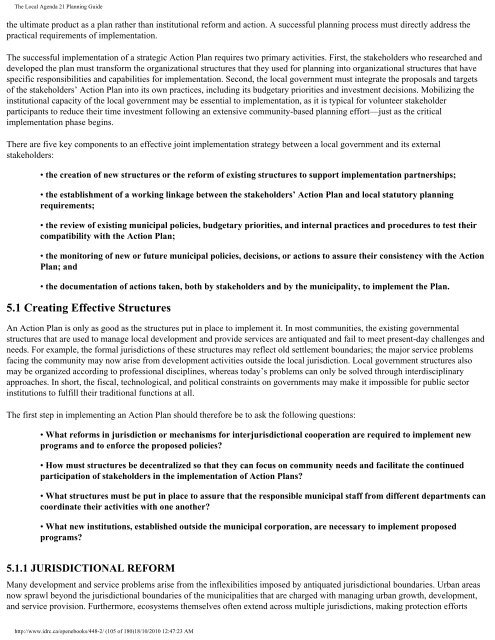The Local Agenda 21 Planning Guide - Democrats Against UN ...
The Local Agenda 21 Planning Guide - Democrats Against UN ...
The Local Agenda 21 Planning Guide - Democrats Against UN ...
Create successful ePaper yourself
Turn your PDF publications into a flip-book with our unique Google optimized e-Paper software.
<strong>The</strong> <strong>Local</strong> <strong>Agenda</strong> <strong>21</strong> <strong>Planning</strong> <strong>Guide</strong><br />
the ultimate product as a plan rather than institutional reform and action. A successful planning process must directly address the<br />
practical requirements of implementation.<br />
<strong>The</strong> successful implementation of a strategic Action Plan requires two primary activities. First, the stakeholders who researched and<br />
developed the plan must transform the organizational structures that they used for planning into organizational structures that have<br />
specific responsibilities and capabilities for implementation. Second, the local government must integrate the proposals and targets<br />
of the stakeholders’ Action Plan into its own practices, including its budgetary priorities and investment decisions. Mobilizing the<br />
institutional capacity of the local government may be essential to implementation, as it is typical for volunteer stakeholder<br />
participants to reduce their time investment following an extensive community-based planning effort—just as the critical<br />
implementation phase begins.<br />
<strong>The</strong>re are five key components to an effective joint implementation strategy between a local government and its external<br />
stakeholders:<br />
• the creation of new structures or the reform of existing structures to support implementation partnerships;<br />
• the establishment of a working linkage between the stakeholders’ Action Plan and local statutory planning<br />
requirements;<br />
• the review of existing municipal policies, budgetary priorities, and internal practices and procedures to test their<br />
compatibility with the Action Plan;<br />
• the monitoring of new or future municipal policies, decisions, or actions to assure their consistency with the Action<br />
Plan; and<br />
• the documentation of actions taken, both by stakeholders and by the municipality, to implement the Plan.<br />
5.1 Creating Effective Structures<br />
An Action Plan is only as good as the structures put in place to implement it. In most communities, the existing governmental<br />
structures that are used to manage local development and provide services are antiquated and fail to meet present-day challenges and<br />
needs. For example, the formal jurisdictions of these structures may reflect old settlement boundaries; the major service problems<br />
facing the community may now arise from development activities outside the local jurisdiction. <strong>Local</strong> government structures also<br />
may be organized according to professional disciplines, whereas today’s problems can only be solved through interdisciplinary<br />
approaches. In short, the fiscal, technological, and political constraints on governments may make it impossible for public sector<br />
institutions to fulfill their traditional functions at all.<br />
<strong>The</strong> first step in implementing an Action Plan should therefore be to ask the following questions:<br />
• What reforms in jurisdiction or mechanisms for interjurisdictional cooperation are required to implement new<br />
programs and to enforce the proposed policies?<br />
• How must structures be decentralized so that they can focus on community needs and facilitate the continued<br />
participation of stakeholders in the implementation of Action Plans?<br />
• What structures must be put in place to assure that the responsible municipal staff from different departments can<br />
coordinate their activities with one another?<br />
• What new institutions, established outside the municipal corporation, are necessary to implement proposed<br />
programs?<br />
5.1.1 JURISDICTIONAL REFORM<br />
Many development and service problems arise from the inflexibilities imposed by antiquated jurisdictional boundaries. Urban areas<br />
now sprawl beyond the jurisdictional boundaries of the municipalities that are charged with managing urban growth, development,<br />
and service provision. Furthermore, ecosystems themselves often extend across multiple jurisdictions, making protection efforts<br />
http://www.idrc.ca/openebooks/448-2/ (105 of 180)18/10/2010 12:47:23 AM










